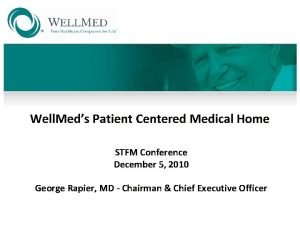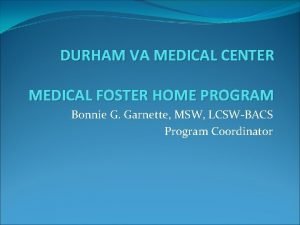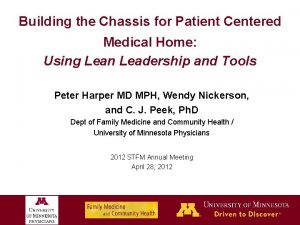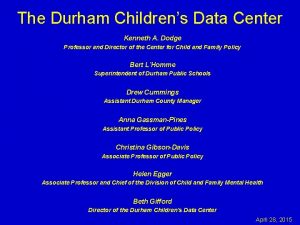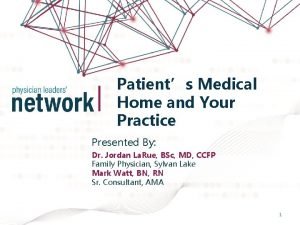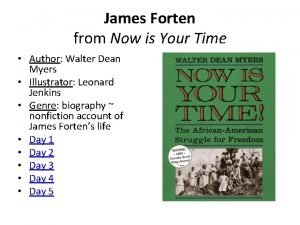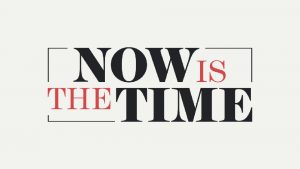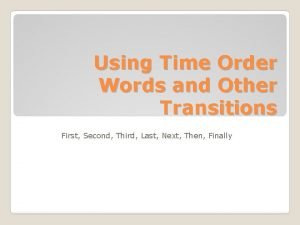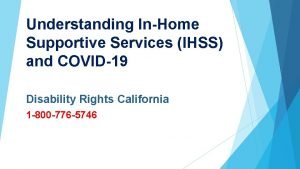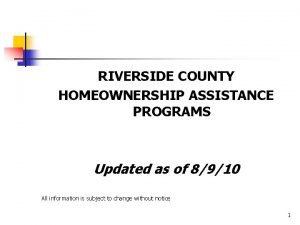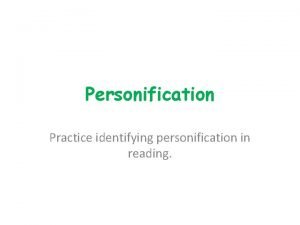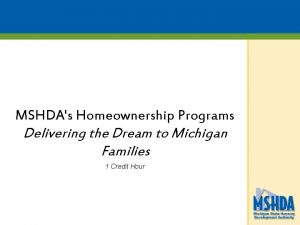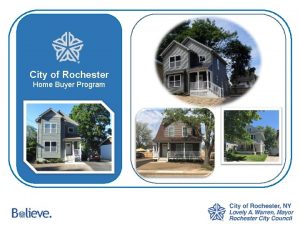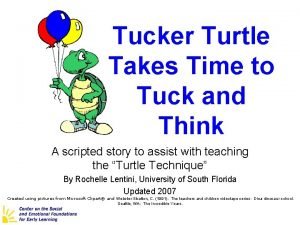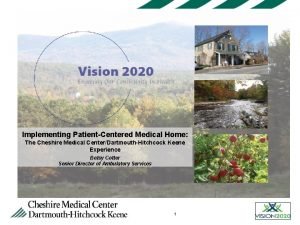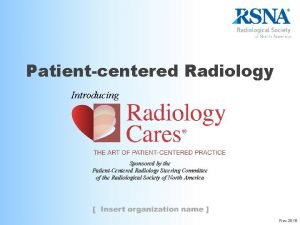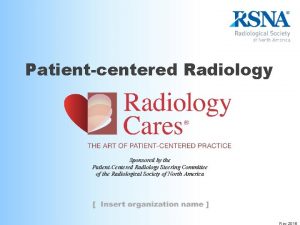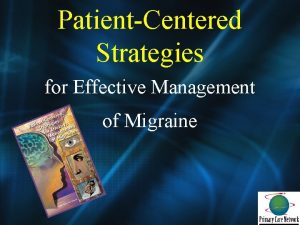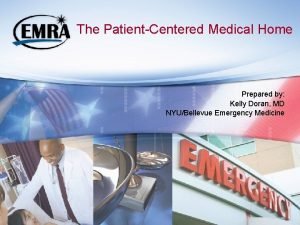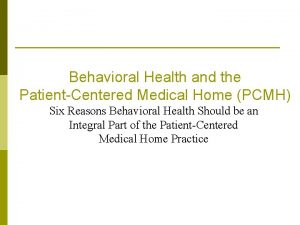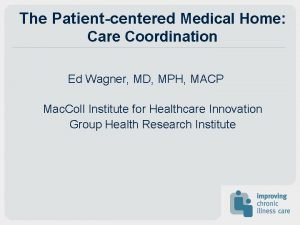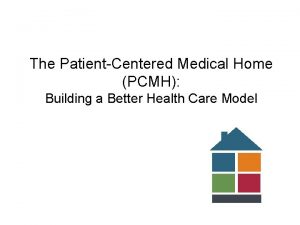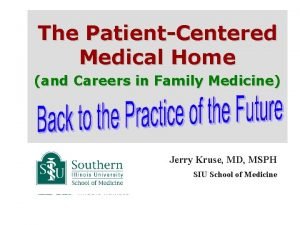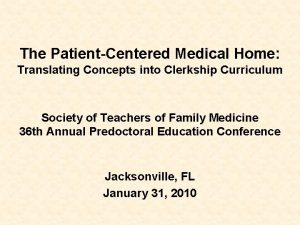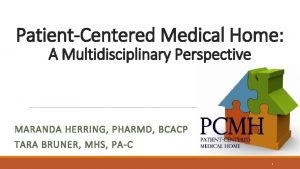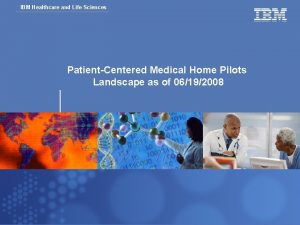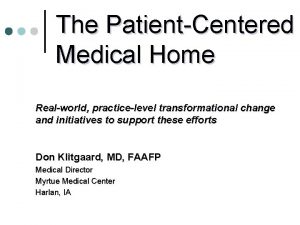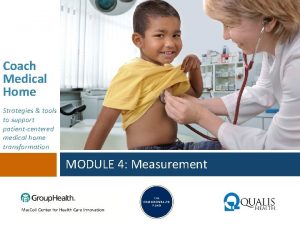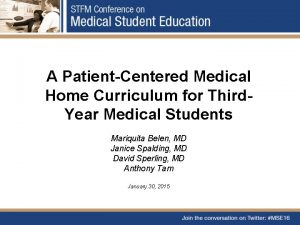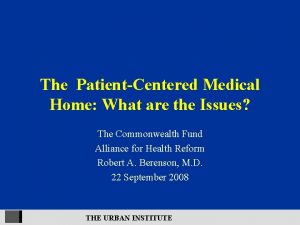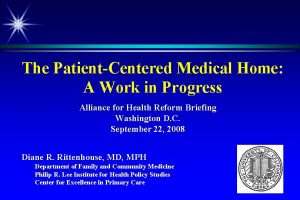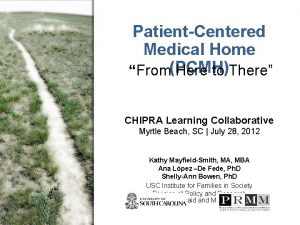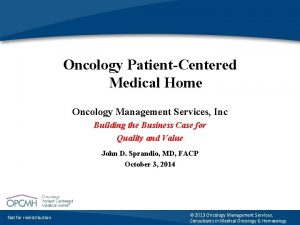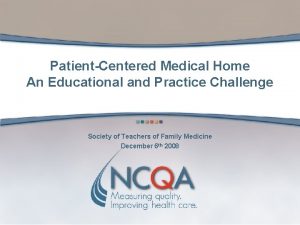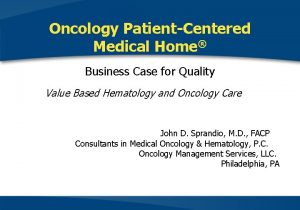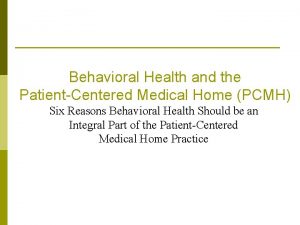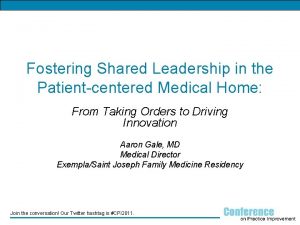The PatientCentered Medical Home The Time Is NOW




































































- Slides: 68

The Patient-Centered Medical Home …The Time Is NOW!!

Learning Objectives • Review goals of PCMH and the need for comprehensive medical care for children, youth, and adults • Define the components of the PCMH model • Evaluate technology needs and develop a plan to project future expectations • Establish realistic time lines for implementation • Clarify decision-making policy in different private practice models • Articulate impact PCMH can have on practice during implementation

Pre-Assessment Please complete your answers on the sheet provided in the syllabus. The aggregate data collected from the pre/post-assessments will be used in an outcomes research article to be published in 2011.

Pre-Assessment Question # 1 The best predictor of patient satisfaction with the health care system is the patient: a. Being from a higher socio-economic class b. Having a higher educational level c. Having an identifiable personal physician d. Living in a rural setting e. Don’t know

Pre-Assessment Question # 2 One of the stated goals of the PCMH is: a. Provide a guide for office practice redesign b. Increase medical student interest in primary care c. Improve the practice payer mix d. Reduce the daily patient load for family physicians e. Don’t know

Pre-Assessment Question # 3 Which of the following is important for overcoming the stress associated with practice redesign? a. Develop a support team b. Plan on frequent turnover of staff and plan accordingly with a temp agency c. Allow all members of the care team to have a turn at being the project leader d. Limit decision making to only senior staff e. Don’t know

WHY?

Primary Care is Foundational • WHO stated in 1978 that primary care “is the key” to attaining “adequate health. ” International Conference on Primary Health Care. Declaration of Alma. Ata. WHO Chron. 1978; 32(11): 428 -430. • Healthcare systems based on primary care have: – – Better quality care Lower costs Less disparity Better population health Stange KC, Miller WL, Nutting PA, et. al. Context for Understanding the National Demonstration Project and the Patient-Centered Medical Home. Ann Fam Med. 2010; 8(Supp 1): S 2 -S 8.

PCMH Will Revitalize Primary Care • It provides a Vision for the future practice of family medicine. • It is a Guide for office redesign that promises better results for patients and for physicians. • It provides a Path to fortify primary care and establish its value in our health system.

WHAT?

History of the Medical Home • First introduced by pediatricians for special needs children in 1967 • IOM advocated for medical homes in 1996 • Future of Family Medicine Project called for a “personal medical home” for all Americans in 2004 • American College of Physicians called for “advanced medical homes” in 2006 • Not a new concept to family physicians

2007 – Joint Statement • Joint declaration by: – – American Academy of Family Physicians American Academy of Pediatrics American College of Physicians American Osteopathic Association • Purposes of the report – – Define the concept Delineate the evidence Determine the agenda for change Develop political support

7 Core Features • • A personal physician Physician-directed medical practice Whole person orientation Coordinated care Quality and safety Enhanced access Payment reform

Personal Physician • Ongoing relationship over time between the patient and the physician • IOM’s Crossing the Quality Chasm - “Continuous healing relationship” http: //www. nap. edu/html/quality_chasm/reportbrief. pdf

Personal Physician • Future of Family Medicine – – “Accepts real responsibility for looking after his/her patient in sickness and in health” – “Commits to sticking with the patient regardless of their health and medical concerns, to help them get appropriate and safe care, matched to their goals” – “Dwells in the community with those they serve and contributes to the life and progress of their community” Future of Family Medicine Project Leadership Committee. The Future of Family Medicine: A Collaborative Project of the Family Medicine Community. Ann Fam Med. 2004; 2(Suppl 1): S 3 -S 32.

Benefits of a Personal Physician • Patients value relationship over everything else • Best predictor of patient satisfaction • Better outcomes and lower overall costs • Eliminates disparities in care • More preventive services http: //www. graham-center. org/Pre. Built/PCMH. pdf

Physician-Directed Practice • Leads a multidisciplinary team that takes responsibility for ongoing care • Change from physician-focused care to team-focused care • Each member of the team feels and takes personal responsibility for the patients • Will require a major paradigm shift • Physician as leader, teacher, and trainer

Physician-Directed Practice • Break the acute care, 10 -15 minute visit model of practice • Paradigm shift from individual patients to population health • Keep the whole patient panel healthy, not just see the patients on today’s schedule • Fewer face-to-face visits and more management by telephone, e-mail (“virtual office visits”), and group visits

We Must Eliminate “Hamster Care!”

Physician-Directed Practice • Chronic care model – Alternative to the acute care model – Disease registries – Team involvement – Group visits – Focused visits/templates – Care plans – Outcomes focused

Whole Person Orientation • Takes responsibility for all health care needs – – • • Acute and chronic care Transgenerational care Preventive services End of life care Utilizes the biopsychosocial model Heart of true “patient-centered” care True patient advocacy within the system “In the context of personal values, across settings, and culturally and linguistically appropriate. ”

Whole Person Orientation • “Comprehensivists” • Accountable for the right care at the right time • Arranging for care with other professionals • Broad Community linkages: – Community agencies – Public Health agencies – Advocacy for underserved

Whole Person Orientation • Patients who don’t get comprehensive whole person care: – Are less satisfied – Feel less enabled/empowered – Have a greater symptom burden – Use more health care resources http: //www. graham-center. org/Pre. Built/PCMH. pdf

Coordinated Care • “Integration” – making a sensible whole out of many parts • Health care is a complex and confusing multifaceted system • Seamless care across all elements – specialty care, hospital, home health agencies, nursing homes, community agencies • Facilitated by registries, information technology, and information exchange

Quality and Safety • Advocate for optimal, patient-centered outcomes • Evidence-based medicine, best practices, and decision support • Continuous quality improvement • Major safety focus

Enhanced Access • Open-access scheduling, extended office hours • New communication options with the PCMH Team – E-mail consultations – Practice web site – Access patient data • Availability 24/7

Payment Reform • Revised system that adequately values the added care provided to patient in a PCMH • Present system rewards consumption and utilization • Reform must enable physicians to deal with complexities of medical, behavioral, and social issues of patients, particularly with chronic illnesses • Proposals usually include basic fee-for-service, plus monthly management fees, plus quality/efficiency bonuses

HOW?



4 Elements of a PCMH • • Practice Organization Health Information Technology Quality Measures Patient Experience


www. transformed. com


www. transformed. com www. pcpcc. net

CERTIFICATION • 2007 – NCQA Launches PPC-PCMH (Physician Practice Connections – Patient. Centered Medical Home) www. ncqa. org

NCQA CERTIFICATION

NCQA CERTIFICATION

CHANGE!? ! Ugh! • Change is tough • No one likes to push out of their comfort zone • Change can be dangerous • But change is one of the few constants in life!

Change is the constant, the signal for rebirth, the egg of the phoenix.

Progress always involves risks. You can't steal second base and keep your foot on first.

CHANGE!? ! Ugh! Crisis = Danger + Opportunity

HOW DO WE LEAD CHANGE? • • • Vision Support Planning Communication Timeframe Perseverance

VISION • • Know exactly what you want to build Know exactly why you want to build it Establish a sense of urgency Paint an exciting picture of the future after the change

Every production of genius must be a production of enthusiasm.

SUPPORT • Find champions and change agents • Build a team to move the change forward • Make sure you have enough resources • Develop broad base of support at all levels of the organization

PLANNING • Realistic assessment of your practice • Divide into 3 areas – What can be kept – What needs to be modified – What needs to go • Stage the changes over 2 -3 years • Plan to get some early wins

COMMUNICATION • Develop a broad-based communication plan • Communicate clearly and concisely • Use every medium of communication available • Repetititon over and over… • Honesty and openness

FEAR is a darkroom where negatives are developed.

TIMEFRAME • Implementing a program is quick, but changing a culture takes a long time • Always takes longer than you think • “The devil is in the details!” • But don’t wait until the plan is perfect to start • Make it a PDSA cycle

PERSEVERANCE • Change is hard work • Changing a culture takes more energy that we anticipate • Develop thick skin! • Develop a strong heart! • Develop a support team!

WILL IT WORK?

NATIONAL DEMONSTRATION PROJECT • Study of varied 36 practices from May 2006 -June 2008 – 31 completed • Mixed findings on PCMH: – Can be built, but may worsen patients’ perceptions of care – Better chronic disease care, but some other quality outcomes worsened – Will require great leadership, motivation, and outside facilitation – Will take more time and resources than predicted Crabtree FB, Nutting PA, et al. Summary of the National Demonstration Project and Recommendations for the Patient Centered Medical Home. Ann Fam Med. 2010; 8(Suppl 1): S 80 -S 90.

MOUNTING EVIDENCE • 2007 prospective cohort study of 756 patients with “life-limiting illnesses” in California • In the “patient-centered” group: – 38% fewer admissions – 36% fewer inpatient days – 30% fewer ED visits • 26% lower costs Sweeney L, Halpert A, Waranoff J. Patient-Centered Management of Complex Patients Can Reduce Costs Without Shortening Life. Am J Manag Care. 2007; 13: 84 -92.

MOUNTING EVIDENCE • Between 1996 and 2005, ED visits increased 20% • Most avoidable with appropriate primary care • Those with “usual source of care” – 7% of care in the ED • Those with “no usual source of care” – 21. 6% of care in the ED Petterson SM, Rabin D, Phillips RL Jr, et al. Having a Usual Source of Care Reduces ED Visits. Am Fam Physician. 2009; 79(2): 94.

MOUNTING EVIDENCE • Study of North Carolina Medicaid claims for asthma in children 1998 -2001 • Fee for service vs Medical Homes • Better use of asthma medications and fewer ED visits and hospital admissions • Spending levels increased, but due to better provision of preventive services Domino ME, Humble C, Lawrence WW Jr, et al. Enhancing the medical homes model for children with asthma. Med Care. 2009; 47(11): 1113– 1120.

MOUNTING EVIDENCE • Geisinger Health System in Pennsylvania • 36 primary care practices with NCQA Level 3 PCMH certification vs control practices • Positive results: – 40% reduction in 30 -day readmissions – 20% reduction in admissions – 7% lower costs Arvantes, J. Geisinger Health System Reports That PCMH Model Improves Quality, Lowers Costs. AAFP News Now. May 26, 2010.



Post-Assessment Please complete your answers on the sheet provided in the syllabus. The questions and answers have been scrambled and are not in the same order as the pre-assessment.

Post-Assessment Question # 1 One of the stated goals of the PCMH is: a. Improve the practice payer mix b. Increase medical student interest in primary care c. Provide a guide for office practice redesign d. Reduce the daily patient load for family physicians e. Don’t know

Post-Assessment Question # 2 Which of the following is important for overcoming the stress associated with practice redesign? a. Limit decision making to only senior staff b. Develop a support team c. Allow all members of the care team to have a turn at being the project leader d. Plan on frequent turnover of staff and plan accordingly with a temp agency e. Don’t know

Post-Assessment Question # 3 The best predictor of patient satisfaction with the health care system is the patient: a. Living in a rural setting b. Having a higher educational level c. Being from a higher socio-economic class d. Having an identifiable personal physician e. Don’t know

Correct Answer # 1 : C One of the stated goals of the PCMH is: a. Improve the practice payer mix b. Increase medical student interest in primary care c. Provide a guide for office practice redesign d. Reduce the daily patient load for family physicians e. Don’t know

Correct Answer # 2 : B Which of the following is important for overcoming the stress associated with practice redesign? a. Limit decision making to only senior staff b. Develop a support team c. Allow all members of the care team to have a turn at being the project leader d. Plan on frequent turnover of staff and plan accordingly with a temp agency e. Don’t know

Correct Answer # 3 : D The best predictor of patient satisfaction with the health care system is the patient: a. Living in a rural setting b. Having a higher educational level c. Being from a higher socio-economic class d. Having an identifiable personal physician e. Don’t know http: //www. graham-center. org/Pre. Built/PCMH. pdf

The Future of Family Medicine looks bright… …build it and they will come!!

Thank You Please complete the session/speaker evaluation located on the back of your pre/post-assessment sheet and return to Chapter staff as you exit.
 Now i see it now you don't
Now i see it now you don't Modal verb past tense
Modal verb past tense Modal verbs worksheet
Modal verbs worksheet Lagi
Lagi Perbedaan home care dan home visit
Perbedaan home care dan home visit South carolina mobile home parks for sale
South carolina mobile home parks for sale Flower plural
Flower plural Softly and tenderly jesus is calling
Softly and tenderly jesus is calling Oak springs rv park
Oak springs rv park Let's go to my house let's go today
Let's go to my house let's go today John heartfield
John heartfield She said that, home economics stands for the ideal home.
She said that, home economics stands for the ideal home. Home sweet home survive crash
Home sweet home survive crash For minutes. start.
For minutes. start. Patient centered medical home conference
Patient centered medical home conference Durham va emergency room
Durham va emergency room Patient centered medical home
Patient centered medical home Medical foster home program
Medical foster home program Your medical home
Your medical home If + past perfect
If + past perfect James forten from now is your time
James forten from now is your time Hamlet soliloquy 5
Hamlet soliloquy 5 New community church glen allen va
New community church glen allen va Time order words
Time order words Ihss parent provider regulations 2020
Ihss parent provider regulations 2020 Ptal california medical board
Ptal california medical board Gbmc medical records
Gbmc medical records Hepburn osteometric board
Hepburn osteometric board Torrance memorial medical records
Torrance memorial medical records Cartersville medical center medical records
Cartersville medical center medical records First time home buyer programs riverside
First time home buyer programs riverside Ice cream personification
Ice cream personification Mshda dpa
Mshda dpa Kevin (go) home by the time i arrived
Kevin (go) home by the time i arrived Rochester first time home buyer
Rochester first time home buyer Tucker turtle steps
Tucker turtle steps Tucker turtle steps
Tucker turtle steps Hình ảnh bộ gõ cơ thể búng tay
Hình ảnh bộ gõ cơ thể búng tay Lp html
Lp html Bổ thể
Bổ thể Tỉ lệ cơ thể trẻ em
Tỉ lệ cơ thể trẻ em Chó sói
Chó sói Tư thế worm breton là gì
Tư thế worm breton là gì Chúa yêu trần thế alleluia
Chúa yêu trần thế alleluia Môn thể thao bắt đầu bằng từ đua
Môn thể thao bắt đầu bằng từ đua Thế nào là hệ số cao nhất
Thế nào là hệ số cao nhất Các châu lục và đại dương trên thế giới
Các châu lục và đại dương trên thế giới Công thức tiính động năng
Công thức tiính động năng Trời xanh đây là của chúng ta thể thơ
Trời xanh đây là của chúng ta thể thơ Mật thư anh em như thể tay chân
Mật thư anh em như thể tay chân Phép trừ bù
Phép trừ bù độ dài liên kết
độ dài liên kết Các châu lục và đại dương trên thế giới
Các châu lục và đại dương trên thế giới Thể thơ truyền thống
Thể thơ truyền thống Quá trình desamine hóa có thể tạo ra
Quá trình desamine hóa có thể tạo ra Một số thể thơ truyền thống
Một số thể thơ truyền thống Cái miệng bé xinh thế chỉ nói điều hay thôi
Cái miệng bé xinh thế chỉ nói điều hay thôi Vẽ hình chiếu vuông góc của vật thể sau
Vẽ hình chiếu vuông góc của vật thể sau Biện pháp chống mỏi cơ
Biện pháp chống mỏi cơ đặc điểm cơ thể của người tối cổ
đặc điểm cơ thể của người tối cổ Giọng cùng tên là
Giọng cùng tên là Vẽ hình chiếu đứng bằng cạnh của vật thể
Vẽ hình chiếu đứng bằng cạnh của vật thể Phối cảnh
Phối cảnh Thẻ vin
Thẻ vin đại từ thay thế
đại từ thay thế điện thế nghỉ
điện thế nghỉ Tư thế ngồi viết
Tư thế ngồi viết Diễn thế sinh thái là
Diễn thế sinh thái là Dot
Dot














